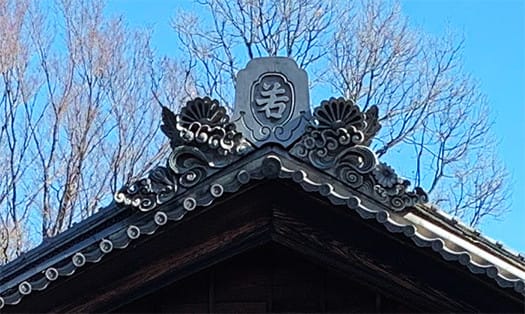


船越の舞台は妻を正面に見せた入母屋造で、大棟端部には鰭に籠彫様の
菊水の文様をあしらった「若」と刻んだ見事な鬼瓦を乗せています。
このように文化施設・舞台建築の頂部に若の文字を乗せるのは、
多くのムラ共同体でその文化面の管理が若者たちに委任されていたことを
物語っていることからです。
江戸期、明治大正くらいまでの「ムラ共同体」社会では若衆・青年組織が
あらゆる共同体活動の中核になっている。
たぶん戦国期まではこの若衆組織が戦国大名たちの実質的な
戦闘集団、軍事組織にもなっていたのでしょう。
いつの世でも、その時代の風俗・流行のようなものには若者は敏感。
この舞台でどういった演目を行い、そしてどういう演者を招くか、
そういった皮膚感覚・感性部分は若者に任されていたのだと思う。
日常の生産の営為を離れた「キラキラした」時間、
若者たちの開放感がこういう舞台空間で広がっていったように思います。
日本民俗の「歌垣」という自由恋愛の伝統を、
非日常的なこうした舞台空間には誘発させるような空気感がある。
日本民俗にとって「歌」とは基本的に男女の恋愛の相聞歌であり、
日本には「三大歌垣」という集団的歌垣の聖地があるのだという。
茨城県の筑波山、兵庫県の歌垣山、佐賀県の杵島山。
これらでは古来からおおらかな自由恋愛伝統が生きてきている。
相聞し相手を定めていったプロセスこそが「歌」だった。
民俗の根源とも思える空気感が、こうした舞台空間にも
アナロジーできる雰囲気が醸成されていたように思う。
このような興業の企画から運営実施までは、
そのムラ共同体の若い人たちが何度も寄り合いを持って
協議し、各自で任務分担も割り振っていたのでしょう。
若衆という民俗文化を想起させる。大人たちとは独立して
「未来の共同体」運営のミニチュア体験も行っていたのでしょう。
そのなかで自由な人間交友が生まれ、共同体の軸になり得る人材も出た。
よく言われるけれど、西郷隆盛という存在はこういう若衆が
そのまま軍事政治の最前線に現れたようなものだったと言われる。
西南戦争最終盤、もう敗勢明らかな局面で敵に夜討ちを掛けるため
夜、西郷率いる部隊が上り坂を匍匐前進していたとき、
「まるで夜這いがごつ、ある」と西郷がつぶやいたので、
これから死地に向かうのに全員の緊張が一気にほぐれたという話がある。
この将の下でなら死んでもいいと思える人間味の部分なのでしょう、
日本民俗の若衆文化のわかりやすいエピソード。
日本の民衆文化のひとつの表現としての
舞台空間からはさまざまな社会の実相が浮かび上がってきます。
English version⬇
[Young people and Mura community culture / Japanese good house ㉛-3]
Funakoshi's stage is an Irimoya-style building with his wife in front, and a basket carving on the fin at the end of the main building.
A splendid onigawara carved with "young" featuring the Kikusui pattern is placed on it.
Putting young characters on the top of cultural facilities and performing arts in this way is
That the cultural management of many Mura communities was delegated to young people
Because it is telling.
In the "mura community" society until the Edo period and the Meiji and Taisho eras, young people and youth organizations
It is at the core of all community activities.
Perhaps until the Warring States period, this youth organization was the substantive of the Warring States lords.
It must have been a combat group and a military organization.
In any world, young people are sensitive to the customs and trends of that era.
What kind of performances will be performed on this stage, and what kind of performers will be invited?
I think that such skin sensations and sensibilities were left to young people.
"Glittering" time away from daily production activities,
I think that the sense of openness of young people spread in this kind of stage space.
The tradition of free love called "Utagaki" of Japanese folk
There is a feeling of inducing atmosphere in such an extraordinary stage space.
For Japanese folklore, "song" is basically a somon song of love between men and women.
It is said that there is a sacred place for collective Utagaki called "Three Great Utagaki" in Japan.
Mt. Tsukuba in Ibaraki Prefecture, Mt. Utagaki in Hyogo Prefecture, and Mt. Kishima in Saga Prefecture.
From ancient times, a laid-back free love tradition has lived in these areas.
The process of talking to each other and deciding the other party was the "song."
The atmosphere that seems to be the root of folklore is also in such a stage space
I think it created an analogical atmosphere.
From the planning of such a business to the implementation of operations
The young people of the Mura community have been close to each other many times
Perhaps they had discussed and assigned their own duties.
Reminiscent of the folk culture of young people. Independent of adults
Perhaps they also had a miniature experience of running a "future community".
Free human friendship was born in that, and some human resources could become the axis of the community.
As is often said, the existence of Saigo Takamori is such a young person.
It is said that it appeared at the forefront of military politics as it was.
In the final stage of the Satsuma Rebellion, in order to slay the enemy at night when the defeat is already obvious
At night, when a unit led by Saigo was crawling down a slope,
Saigo muttered, "It's like a night crawling."
There is a story that everyone's tension was released at once as they headed to the dead zone.
It's a human part that I can die under this general,
An easy-to-understand episode of Japanese folk culture.
As an expression of Japanese popular culture
From the stage space, the reality of various societies emerges.



















